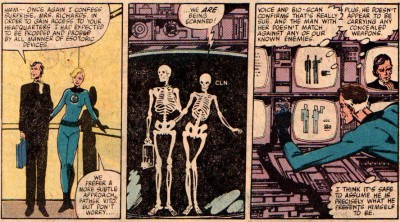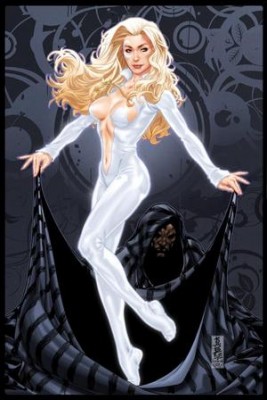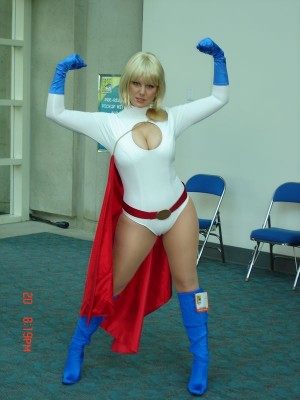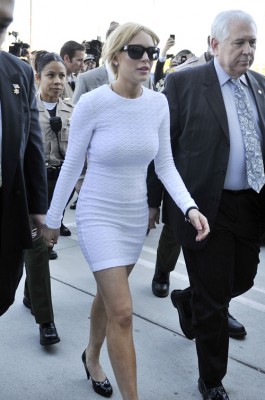Spider-Man has joined the Fantastic Four. Actually, he’s joined something called “The Future Foundation [1].” One member of the Fantastic Four, Johnny Storm AKA the Human Torch, was recently “rebooted to the curb [2].” And, although the Fantastic Four is no longer calling itself “the Fantastic Four,” they still needed “a fourth.” Hence, the inclusion of Spider-Man.
There are a number of disturbing aspects of this story. It is one of cynicism, corporatism, and psychosexual braggadocio. I intend to touch on all of these aspects in the compelling and thought-provoking essay below.
I. Spider-Man is everywhere.
Spider-Man is carrying the fate of the entire entertainment world on his shoulders. If Spider-Man fails, entire economies in publishing, stage, and film, will collapse. Unfortunately, all signs point to a dangerous “Spider-Man Bubble” that is certain to pop, leaving millions of fanboys confused, irritated, and in desperate need of a bailout.
Spider-Man was created circa 1962 by Stan Lee and Steve Ditko. Jack Kirby claims to have had a hand in his creation, apparently because he helped create a character called “The Silver Spider” a few years before — it’s convoluted [3], like comic book continuity. As Ditko himself put it in an essay called “An insider’s part of comics history: Jack Kirby’s Spider-Man,” in his book “Avenging World [4],”
“In a discussion with me about Spider-man, Stan said he liked the name Hawkman but DC had he name and the character. Marvel would add Ant-man (and the Wasp) so it would have an insect category. (Technically, a spider is not an insect.) From that, I believed Stan had named the character.
Who first came up with the specific name, Spider-man, is for Stan and Jack to resolve. Stan said Spider-man would be a teenager with a magic ring that could transform him into an adult hero — Spider-man. I said it sounded like the Fly, which Joe Simon had done for Archie Publications…
Stan called Jack about it but I don’t know what was discussed. I never talked to Jack about Spider-man, so I don’t know what his ideas concerning the characters actually were.
Later, at some point, I was given the job of drawing Spider-man. Why, exactly? Stan and Jack also have to clear that up.
One of the first things I did was to work up a costume. A vital, visual part of the character, I had to know how he looked, to fit in with the powers he had, or could have, the possible gimmicks and how they might be used and shown, before I did any breakdowns. For example: A clinging power, so he wouldn’t have hard shoes or boots, a hidden wrist-shooter versus a web gun and holster, etc.
The creation of the costume is a story in itself. Some brief points: The obvious one is the use of the spider theme and the webbing design; I wasn’t sure Stan would like the idea of covering the character’s face but I did it because it hid an obviously boyish face. It would also add mystery to the character and allow the reader/viewer the opportunity to visualize, to “Draw,” his own preferred expression on Peter Parker’s face and, perhaps, become the personality behind the mask. Did it would that way? (There are interesting psychological theories about masks.)
Unfortunately, the book isn’t widely available, but if you can find a copy of “Avenging World,” please read everything in it.
Spider-Man was created to be a loner character. He was the studious “science major” high school student, shunned by his peers, who had the misfortune to gain powers related to that creepiest of creatures, a spider. As Stan Lee put it in his introduction to the first volume of the Marvel Masterworks: Spider-Man [5] series:
“You can’t name a hero ‘Spider-Man’ because people hate spiders!
You can’t feature a teenager as a super hero. Teenagers can only be sidekicks…
You can’t give a hero so many problems. Readers won’t think he’s heroic enough.
You can’t have a hero who isn’t big and glamorous and handsome. (Peter was just your average nerdy type of student in those days.)
You can’t have a hero whose Aunt May is always wet-nursing him. It’s not macho enough.”
The point is, Spider-Man is now 49 years old. He was created to be a solitary figure (despite his efforts to the contrary – see below) and was for much of his career. He appeared in Marvel Team-Up, a comic book in which he was teamed with various Marvel characters, mostly to help maintain the trademarks on little-used characters, and for awhile starred in the television show “Spider-Man and his Amazing Friends.” But now?
In addition to his membership in the Future Foundation, Spider-Man is also a member of The Avengers [6]. And The New Avengers [7] (along with another Future Foundation member, The Thing). His “solo stories [8]” appear in four other comic books. He has a day job as a “research scientist [9].”
His films were [10] massively [11] popular [12]. Next year’s “reboot,” which is officially to be called “The Amazing Spider-Man” (that bit of information warranted a press release [13]) is one of the most anticipated films of 2012. His Broadway play [14], “Spider-Man: Turn off the Dark [15],” is the only Broadway play that anyone outside of New York City has even heard of. More television shows are coming.
As of right now, Marvel’s only other “go-to” character is Wolverine, who appears in as many comics as Spider-Man. He has appeared now in four films, with a fifth on the way [16]. But as yet, he hasn’t been tapped to star in a Broadway show. There have been no songs written for him (actually, there probably have, but I’m not aware of them). But Wolverine’s popularity hasn’t reached nearly the heights of Spider-Man’s. Just check the grosses [17] for the films in which he’s appeared, against those for the films in which Spider-Man appears. For that matter, check his grosses against the Fantastic Four [18] films. No contest.
II. The Fantastic Four was the ultimate comics magazine.
Comic books measure time in metal-named “ages.” First was the golden age, in which was born the very concept of the comic book, and classic superheroes like Superman, Batman, Wonder Woman, and Plastic Man. Then came the silver age, in which we got new versions (reboots) of Flash and Green Lantern, and The Fantastic Four and Spider-Man. During the bronze age we got the Punisher, Wolverine and all the re-booted X-Men, the Teen Titans, and Howard the Duck. Next was, um, the tin age [19]? Maybe; I’m not sure, but that was when was born the New Teen Titans, the New Mutants, and Watchmen. And now we’re in the recycled age [20] of comics (not to be confused with the green age [21] of comics) in which everything is being re-booted and recycled ad nauseum ad infinitum.
In a lot of ways, the Fantastic Four [22] was, if not “The World’s Greatest Comics Magazine,” as its cover boasted from the beginning, “The Ultimate Comics Magazine,” because it represented all the tools of the comics creators’ arsenal. All of the characters were recycled or re-imagined from earlier characters and concepts. For instance, the Human Torch was a re-imagining of the golden age Human Torch [23]. The giant rock man called The Thing was basically a Golem [24]. The Invisible Girl was a woman whose power was to turn herself invisible, which wasn’t uncommon during the golden age – Invisible Scarlet O’Neil [25] was one of the more enduring and you probably haven’t heard of her, which should give you some indication of the number of concepts that were tried, and upon which the creators of silver age comics drew for inspiration. Check out Trina Robbins’s book The Great Women Superheroes [26] for more. (And it’s important for anyone who talks about the history of the Fantastic Four to point out the ironical appropriateness of calling a female hero “The Invisible Girl” in the pre-feminist movement 1961 – she’s invisible, and although a grown woman, she’s called a “girl!”) And Mr. Fantastic was basically just a less interesting and less clever version of The Elongated Man [27], who was himself a pale and sad imitation of the great Jack Cole [28]‘s Plastic Man [29].
Now, in the heart of the recycled age, the Fantastic Four is being rebooted as the Future Foundation. Without a Human Torch, and with a Spider-Man. In his first issue, which appeared less than a year after the first issue of the Fantastic Four, Spider-Man actually attempted to join the Fantastic Four, because he needed money. However, as the Invisible Girl explains, the FF is “a non-profit organization!”
Another one, probably Mr. Fantastic, continues: “We just keep enough money to pay our expenses! Every other cent goes into developing the most effective super-crime-fighting apparatus we can create!” (Spider-Man Vs. The Chameleon!, page 4)
I often wondered where it was exactly that the FF got its money. Who paid them to fight crime? I think we’re beginning to get our answer, and it leads to –
III. The Future Foundation: A Fantastic Conspiracy
In issue number 233 of the Fantastic Four, cover dated August 1981, we see one of Mr. Fantastic/Reed Richards’s fantastic “super-crime-fighting apparatus:”
This backscatter x-ray technology is currently being used in airports [31] across the country.
The Fantastic Four and now the Future Foundation’s comics are published by Marvel comics. As we know, just after the inauguration, Spider-Man made an appearance [32] with the current president.
We also know that Captain America recently went to battle against the Tea Party [33].
Clearly, Marvel comics and the characters depicted in its publications have a pro-big-government agenda. And why not? The government is a major purchaser of Mr. Fantastic’s “super-crime-fighting apparatuses.” The bigger the government, the more money it has to purchase Mr. Fantastic’s inventions.
For his part, the president has been promoting Marvel’s characters. During the presidential campaign, he declared that Spider-Man was his favorite [34]superhero. Recently, he quoted [35] Spider-Man at a press conference.
Spider-Man has now joined the Future Foundation.
And, during the state of the union address, the president employed the phrase “Win the Future [36]” approximately 450 times. One month later, the Human Torch is dead, and the Fantastic Four has been renamed “The Future Foundation.” The state of the union was nothing more than an extended commercial for a new superhero group, featuring one of the president’s favored constituents.
But this gets a lot worse. Remember too that the president employed the head-scratcher phrase “our Sputnik moment [37].” Supposedly this was in reference to “investment in innovation.” Like Mr. Fantastic’s backscatter x-ray machine, no doubt. Critics wondered why it was the president would reference a costly propaganda [38] event by a totalitarian empire in which millions of people [39] were living in poverty and starving to death. To those who know the history of the Fantastic Four, however, the message was clear.
It was a call-back to their fantastic origin story! In the first issue, page 9, Sue Storm, the future Invisible Girl, tells Ben Grimm, the future Thing, that they’ve got to test Reed Richards’s experimental rocket, “unless we want the commies to beat us to it!”
Sputnik signaled the beginning of the “space race.” It was in the heat of that race that the Fantastic Four was born. And now, we must “win the future.” And what better organization to help us with that than – The Future Foundation?
IV. The sex lives of superheroes, and the mystery of the Future Foundation’s new white costumes.
Much has been made about the new costumes in which the members of the Future Foundation will ply their trade. As you can see, the costumes are mostly white, with a bit of black designwork.
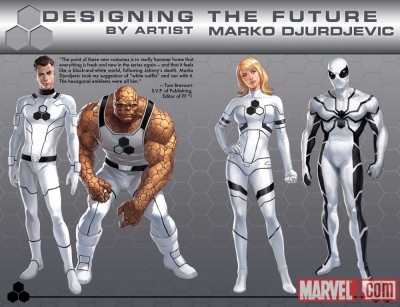 [41]
[41]
Fanboy response has centered primarily on the fact that the costumes are white. White fabric is difficult to keep clean, they say. But certainly Mr. Fantastic, who created the “unstable molecule [42]” fabric employed by many superhero characters (it stretches with his body, and conforms to every contour of every muscle and curve of every character), can create a fabric that will maintain its cleanliness.
Moreover, the white superhero costume isn’t completely unheard-of. Dagger had one.
And Power Girl.
Lindsay Lohan recently employed one to great effect [45].
The real question is, why did the Future Foundation put penises on their chests?
Look closely at the image of the costumes being worn by Mr. Fantastic, the Invisible Woman, and the Thing. Each of them employs a very stylized penis and testicles insignia. On Mr. Fantastic’s chest we see the penis pointing straight into the air, with two balls dangling proudly beneath. On the Invisible Woman’s chest we see the flaccid penis dangling left. For the Thing, the flaccid penis dangles to the right.
Many artists have claimed that creation comes from their sex organs [47]. Comic book superheroes are wish-fulfillment fantasies, plain and simple. The readers are meant to identify with the alter-ego of a supercharacter – put upon and wet-nursed by an elderly aunt, a la Spider-Man – while being inspired by the greatness achieved by the that character when he puts on his tights and cape.
Now let us consider Mr. Fantastic. The entire world knows him as Reed Richards. He is his own “alter ego.” He is always treated with respect, he is never put-upon, he doesn’t have an aunt wet-nursing him. He is also arrogant, pedantic, and dull. But he can stretch.
He can adjust the length and girth of any part of his body to exactly the size he desires.
The man who can stretch is a recurring theme in superheroics. I’ve already mentioned Plastic Man and Elongated man, but there was also Stretch Armstrong and Elastic Lad [48]. Plastic Man was recently rebooted [49] in his own regular series. Stretch Armstrong is being made into a film [50].
What man wouldn’t want the ability to adjust his body? What woman wouldn’t want to be with such a man?
(And for such a man to be married to an Invisible Woman – who can make herself or parts of herself invisible – who can project force fields – try to imagine the “fantastic” lovemaking sessions these two must enjoy!)
As for the Thing – he is a giant man made of rock. He’s had at least one girlfriend [51] in the past, but how could any woman handle such a creature? He would be perpetually hard, with no worries about impotency, and yet, unable to satisfy himself or any woman. He’s made of rock!
Take a look at the ways in which Mr. Fantastic and the Thing are standing in the official Marvel comics images of the new Future Foundation costumes above. Mr. Fantastic stands arrogantly, with his genitals thrust forward, toward the future. A future that he could fill with dozens of offspring, copulating with dozens of women at the same time, hundreds of miles away – Mr. Fantastic could sleep with women in other countries, all at the same time, with none of them knowing about the others! (The writer and filmmaker Alejandro Jodorowsky posited [52] that Mr. Fantastic could stretch his penis until it was so thin and so long that he could maneuver it through her veins and ejaculate directly into the Invisible Woman’s heart.) Meanwhile, the Thing stands with his hands over his rock hard but useless crotch, which he seems to be pulling away from the reader. As if in shame.
Mr. Fantastic, the arrogant blowhard, has put the very emblem of his superiority on the chests of his teammates. He is a “dick,” with a fantastic “dick.”
Spider-Man, who no doubt has the sexual prowess of a spider, does not get such treatment – Mr. Fantastic at least respects Spider-Man enough for that. Spider-Man is there for sales reasons, and his costume hews closely to his current merchandising.
V. In conclusion.
The Future Foundation is biggest psychosexual corporatist superhero conspiracy ever to be unleashes upon an unsuspecting fandom. It represents what is no doubt a last gasp of the “superhero bubble,” which is set to implode any day now. By throwing literally everything into the book — reboots, death, Spider-Man, sex — they are attempting to prop up a dying institution.
- Author Bio [53]
- Latest Posts [54]
Ricky Sprague [55]
Latest posts by Ricky Sprague (Posts [59])
- Meet the start-ups that are thriving in the current economic recovery [60] - May 27, 2016
- How a Wonder Woman comic from 1942 led to the Great California Cow Exodus of 2012, maybe [61] - November 28, 2012
- A common-sense approach to restoring economic prosperity [62] - November 19, 2012
- New Philip K. Dick novel too absurd to be believed [63] - September 17, 2012
- My 90 Days, 90 Reasons submission [64] - September 12, 2012
